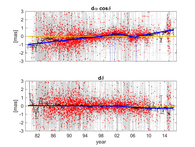Objectives
All objectives of project ECORAS aim for improvements of the current conventional realization of the International Celestial Reference System (ICRS). The current ICRF (International Celestial Reference Frame) as a realization of the ICRS is the main product of astrometric VLBI and its main contribution to astronomy. A variety of scientific investigations and technical applications rely on it. An improved ICRF means more accurate positions of the celestial radio sources. It would allow for more accurate space navigation and ephemeris calculation (if based on radio sources), and would improve the determination of Earth orientation parameters and of the International Terrestrial Reference Frame (ITRF). The latter are essential for many applications of global navigation satellite systems (GNSS), such as the Navstar Global Positioning System (GPS) or the upcoming GALILEO satellite navigation system. Main goal of project ECORAS is the extension of the parameterization of radio sources coordinates observed by VLBI.
VLBI astrometry depends on the number and quality of group delay observations as well as on the accuracy of the models applied within the data analysis. Thus, astrometry can be improved on the one hand whenever the instruments and electronics of the receiving system and its applications specified by the observational schedules are advanced; and on the other hand if the theoretical background is correctly understood and supplied in terms of more accurate analysis models.
With project ECORAS we want to achieve improvements of the ICRF on the model side by analyzing all available VLBI observations. Fundamental progress on the celestial reference frame can be expected - in principle - from two approaches, which will be realized by project ECORAS:
- Considering apparent proper motions caused by the nature of the radio sources.
- Identifying, quantifying, modeling and interpreting existing systematic apparent proper motions of the radio source field.
ECORAS-2
The optical astrometric satellite mission Gaia (ESA) is going to provide positions and proper motions of radio sources at a level of precision comparable to current VLBI (Very Long Baseline Interferometry) or even better. In the 2nd phase of the project ECORAS, the comparison of the Gaia and VLBI celestial coordinates will be exploited for the determination of systematic reference frame effects, such as the Galactic aberration, primordial gravitational waves, gravitational lensing and comparable deformations due to inter-stellar mater. The comparison will also reveal important details about possible technique-dependent systematic errors of the VLBI and Gaia coordinates. Steps towards these important scientific goals are the detection, modelling and correction of radio source structure effects on celestial coordinates and observables. The evolution of intrinsic structure caused by astrophysical processes can cause very large apparent proper motions and hence, it needs to be considered to enable the precise comparisons. Likewise, the comparison requires an accurate orientation of the VLBI and Gaia reference frames. In the focus of the second part of project ECORAS is the alignment of the two radio and optical wavelengths-based frames. The same celestial object is very likely to appear at different positions depending on the observed frequency, an effect that needs to be considered for the precise tie of radio and optical reference frames.
Project Team
- Project Lead: Robert Heinkelmann (GFZ); Harald Schuh (GFZ/TU Berlin)
- Mercator Fellow: Minghui Xu (Aalto University Metsähovi Radio Observatory, Finland)
- Main scientists: James Anderson (TU Berlin), Susanne Lunz (GFZ)
Collaboration
- IAU Division A WG on the Third Realization of the International Celestial Reference Frame (ICRF3)
- IAG Sub Commission 1.4 Interaction of Celestial and Terrestrial Reference Frames
- Prof. Sergei Klioner, Lohrmann Observatory, TU Dresden, regarding CRF - Gaia comparison
References
Belda, S., R. Heinkelmann, J. Ferrandiz, T. Nilsson, H. Schuh (2017): On the consistency of the current conventional EOP series and the celestial and terrestrial reference frames. Journal of Geodesy, doi: 10.1007/s00190-016-0944-3, online first
Karbon, M., R. Heinkelmann, J. Mora-Diaz, M. Xu, T. Nilsson, H. Schuh, (2016): The extension of the parametrization of the radio source coordinates in geodetic VLBI and its impact on the time series analysis. Journal of Geodesy, Special Issue "VLBI contribution to reference frames and Earth's rotation studies", doi: 10.1007/s00190-016-0954-1, online first
Xu, M., R. Heinkelmann, J.M. Anderson, J. Mora-Diaz, M. Karbon, H. Schuh, G. Wang (2016a): The impacts of source structure on geodetic parameters demonstrated by the radio source 3C371. Journal of Geodesy, Special Issue "VLBI contribution to reference frames and Earth's rotation studies", doi:10.1007/s00190-016-0990-x, online first
Xu, M., R. Heinkelmann, J.M. Anderson, J. Mora-Diaz, H. Schuh, G. Wang (2016b): The source structure of 0642+449 detected from the CONT14 observations. The Astronomical Journal, Volume 152, Issue 5, 11 pp., doi: 10.3847/0004-6256/152/5/151
Fey A.L., D. Gordon, C.S. Jacobs, C. Ma, R.A. Gaume, E.F. Arias, G. Bianco, D.A. Boboltz, S. Boeckmann, S. Bolotin, P. Charlot, A. Collioud, G. Engelhardt, J. Gipson, A.-M. Gontier, R. Heinkelmann, S. Kurdubov, S. Lambert, S. Lytvyn, D.S. MacMillan, Z. Malkin, A. Nothnagel, R. Ojha, E. Skurikhina, J. Sokolova, J. Souchay, O.J. Sovers, V. Tesmer, O. Titov, G. Wang, V. Zharov (2015): The Second Realization of the International Celestial Reference Frame by Very Long Baseline Interferometry. The Astronomical Journal, Volume 150, Issue 2, 58 pp., doi: 10.1088/0004-6256/150/2/58
Raposo-Pulido, V., E. Tanir Kayikci, R. Heinkelmann, T. Nilsson, M. Karbon, B. Soja, C. Lu, J. Mora-Diaz, H. Schuh (2015): Impact of Celestial Datum Definition on EOP Estimation and CRF Orientation in the Global VLBI Session IYA09. In: Rizos C., Willis P. (eds) IAG 150 Years. International Association of Geodesy Symposia, Vol. 143, pp. 141-147, doi: 10.1007/1345_2015_106
Xu, M., J.M. Anderson, R. Heinkelmann, H. Schuh, G. L. Wang (2015): Estimating the velocity of the barycenter of the solar system from VLBI observations. In: Haas, R. & Colomer, F. (eds.) Proc. of the 22nd EVGA Working Meeting, 224-227, http://evga2015.raege.net/EVGA2015_proceedings.pdf
Raposo-Pulido, V., S. Lambert, N. Capitaine, T. Nilsson, R. Heinkelmann, H. Schuh (2014): On the systematics in apparent proper motions of radio sources observed by VLBI. In: Malkin Z., Capitaine N. (eds.) Proceedings of the Journees Systemes de Reference Spatio-temporels 2014, 9-11, https://syrte.obspm.fr/jsr/journees2014/pdf/Raposo-Pulido.pdf
Xu, M., R. Heinkelmann, H. Schuh, M. Zhao, G. Wang (2014): The Acceleration of the Origin of the ICRF. In: Behrend D., Baver K.D., Armstrong K.L. (eds.) IVS 2014 General Meeting Proceedings “VGOS: The New VLBI Network”, Science Press (Beijing), 412-416, ftp://ivscc.gsfc.nasa.gov/pub/general-meeting/2014/pdf/089_Xu_etal.pdf
Heinkelmann R.: VLBI geodesy: observations, analysis, and results. In: Geodetic sciences – observations, modeling and applications. Jin S. (edt.), InTech open, ISBN 980-953-307-595-7, online first, www.intechopen.com/articles/show/title/vlbi-geodesy-observations-analysis-and-results, 127—156, 2013
Heinkelmann R., Tesmer V.: Systematic inconsistencies between VLBI CRF and TRF solutions caused by different analysis options. In: Reference Frames for Applications in Geosciences, International Association of Geodesy Symposia, Vol. 138, Altamimi Z., Collilieux X. (edts.), Springer-Verlag Berlin Heidelberg, DOI 10.1007/978-3-32998-2_27, 181—189, 2013
Schuh H., Böhm J.: Very Long Baseline Interferometry for Geodesy and Astrometry. In: Sciences of Geodesy – II, Innovations and Future Developments, G. Xu (ed.), DOI 10.1007/978-3-642-28000-9, Springer-Verlag Berlin Heidelberg, 339—376, 2013
Schuh H., Behrend D.: VLBI: A fascinating technique for geodesy and astrometry. J Geodyn 61, DOI 10.1016/j.jog.2012.07.007, 68—80, 2012
Heinkelmann R., Schuh H.: Very long baseline interferometry: accuracy limits and relativistic test. In: Relativity in Fundamental Astronomy (IAU S261), Proceedings of the International Astronomical Union Symposia and Colloquia, Klioner S.A., Seidelmann P.K., Soffel M.H. (edts.), DOI 10.1017/S1743921309990524, Cambridge University Press, 286—290, 2010
Ma C., Arias E.F., Bianco G., Boboltz D.A., Bolotin S.L., Charlot P., Enhelhardt G., Fey A.L., Gaume R.A., Gontier A.-M., Heinkelmann R., Jacobs C.S., Kurdubov S., Lambert S.B., Malkin Z.M., Nothnagel A., Petrov L., Skurikhina E., Sokolova J.R., Souchay J., Sovers O.J., Tesmer V., Titov O.A., Wang G., Zharov V.E.: The Second Realization of the Celestial Reference Frame by Very Long Baseline Interferometry, International Earth Rotation and Reference Systems Service (IERS), Technical Note No. 35, Verlag des Bundesamts für Kartographie und Geodäsie, Frankfurt am Main, www.iers.org/TN35, 2009
Heinkelmann R., Böhm J., Schuh H.: Effects of geodetic datum definition on the celestial and terrestrial reference frames determined by VLBI, in: Proceedings of the 18th Working Meeting on European VLBI for Geodesy and Astrometry, J. Boehm, A. Pany, H. Schuh (edts.), ISSN 1811-8380, pp 200—205, www.evga.org/files/2007EVGA-proc_Vienna.pdf, 2007
Schuh H., Heinkelmann R., Sokolova J., Tesmer V.: Sub-Commission 1.4 Interaction of Celestial and Terrestrial Reference Frames, Final Report – May 2007, in: Travaux International Association of Geodesy, Vol. 35, O.B. Andersen (ed.), iag.dgfi.badw.de/fileadmin/IAG-docs/Travaux_2003-2007.pdf, pp 42—47, 2007



